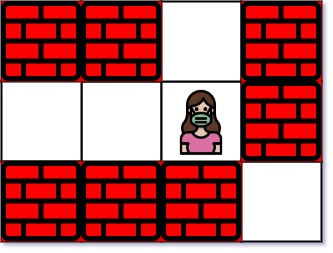[LeetCode] 1926. Nearest Exit from Entrance in Maze
You are given an m x n matrix maze (0-indexed) with empty cells (represented as '.') and walls (represented as '+'). You are also given the entrance of the maze, where entrance = [entrancerow, entrancecol] denotes the row and column of the cell you are initially standing at.
In one step, you can move one cell up, down, left, or right. You cannot step into a cell with a wall, and you cannot step outside the maze. Your goal is to find the nearest exit from the entrance. An exit is defined as an empty cell that is at the border of the maze. The entrance does not count as an exit.
Return the number of steps in the shortest path from the entrance to the nearest exit, or -1 if no such path exists.
Example 1:

Input: maze = [["+","+",".","+"],[".",".",".","+"],["+","+","+","."]], entrance = [1,2] Output: 1 Explanation: There are 3 exits in this maze at [1,0], [0,2], and [2,3]. Initially, you are at the entrance cell [1,2]. - You can reach [1,0] by moving 2 steps left. - You can reach [0,2] by moving 1 step up. It is impossible to reach [2,3] from the entrance. Thus, the nearest exit is [0,2], which is 1 step away.
Example 2:

Input: maze = [["+","+","+"],[".",".","."],["+","+","+"]], entrance = [1,0] Output: 2 Explanation: There is 1 exit in this maze at [1,2]. [1,0] does not count as an exit since it is the entrance cell. Initially, you are at the entrance cell [1,0]. - You can reach [1,2] by moving 2 steps right. Thus, the nearest exit is [1,2], which is 2 steps away.
Example 3:

Input: maze = [[".","+"]], entrance = [0,0] Output: -1 Explanation: There are no exits in this maze.
Constraints:
maze.length == mmaze[i].length == n1 <= m, n <= 100maze[i][j]is either'.'or'+'.entrance.length == 20 <= entrancerow < m0 <= entrancecol < nentrancewill always be an empty cell.
迷宫中离入口最近的出口。
给你一个 m x n 的迷宫矩阵 maze (下标从 0 开始),矩阵中有空格子(用 '.' 表示)和墙(用 '+' 表示)。同时给你迷宫的入口 entrance ,用 entrance = [entrancerow, entrancecol] 表示你一开始所在格子的行和列。
每一步操作,你可以往 上,下,左 或者 右 移动一个格子。你不能进入墙所在的格子,你也不能离开迷宫。你的目标是找到离 entrance 最近 的出口。出口 的含义是 maze 边界 上的 空格子。entrance 格子 不算 出口。
请你返回从 entrance 到最近出口的最短路径的 步数 ,如果不存在这样的路径,请你返回 -1 。
来源:力扣(LeetCode)
链接:https://leetcode.cn/problems/nearest-exit-from-entrance-in-maze
著作权归领扣网络所有。商业转载请联系官方授权,非商业转载请注明出处。
这道题依然属于比较经典的 flood fill 类型的题。同时既然是找最短路径,那么做法就一定是 BFS。这道题我提供的代码是直接在 input 数组进行修改,当我遇到不是矩阵边缘的空格之后,我把它标记成砖头,这样下次我就不会再重复访问这个坐标了。注意因为起点一定不在矩阵的边缘所以即使最后找不到入口,也起码会移动一步来试探所有的可能性,所以最后返回 steps 的时候要 + 1。
时间O(mn)
空间O(n)
Java实现
1 class Solution { 2 public int nearestExit(char[][] maze, int[] entrance) { 3 int m = maze.length; 4 int n = maze[0].length; 5 int[] dx = {-1, 1, 0, 0}; 6 int[] dy = {0, 0, -1, 1}; 7 Queue<int[]> queue = new LinkedList<>(); 8 queue.offer(new int[] { entrance[0], entrance[1] }); 9 maze[entrance[0]][entrance[1]] = '+'; 10 int steps = 0; 11 while (!queue.isEmpty()) { 12 int size = queue.size(); 13 for (int i = 0; i < size; i++) { 14 int[] cur = queue.poll(); 15 for (int k = 0; k < 4; k++) { 16 int newX = cur[0] + dx[k]; 17 int newY = cur[1] + dy[k]; 18 // 跳过越界的坐标和带加号的坐标 19 if (newX < 0 || newX >= m || newY < 0 || newY >= n) { 20 continue; 21 } 22 if (maze[newX][newY] == '+') { 23 continue; 24 } 25 // 剩下的就是范围内的坐标,如果这个坐标在grid边界上,那么就是找到了出口 26 if (newX == 0 || newX == m - 1 || newY == 0 || newY == n - 1) { 27 return steps + 1; 28 } 29 maze[newX][newY] = '+'; 30 queue.offer(new int[] {newX, newY}); 31 } 32 } 33 steps++; 34 } 35 return -1; 36 } 37 }



